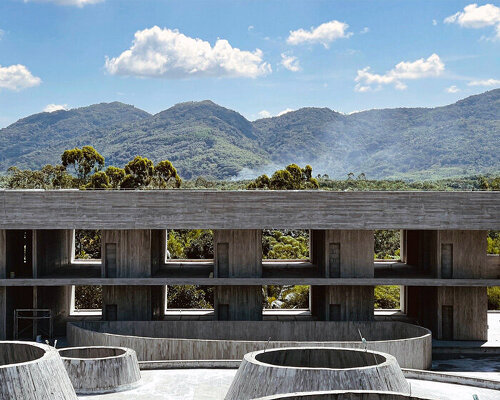rain house: A Building Shaped by Weather
The Rain House by SynchroniCity Architects stands on an elevated hill in Hainan, where the rhythm of rain defines both landscape and life. Conceived during a sudden downpour, its design began with an observation of the site’s behavior under shifting weather. Rain reveals the contours of the terrain, carving paths of runoff and delineating subtle boundaries between water and land.
From these fleeting lines, the architects established the project’s datum — a five-meter elevation that lifts the building above the floodplain while aligning it with the natural order revealed by the storm.
Hainan’s monsoon climate calls for a building that’s resilient. The island’s humid air and violent typhoons leave few choices in material. Concrete became both structure and defense — dense enough to resist wind and erosion, steady enough to support life through extremes. The broad eaves, drawn far from the walls, follow the same pragmatic logic. They temper sunlight and redirect slanting rain to create sheltered passages that remain breathable and open to air.
images © Wang Ning, An Li, Guo Xi, Han Tao
Courtyard as Gathering Space
From its elevated base, SynchroniCity’s Rain House develops upward toward a square courtyard. The form recalls familiar spatial traditions, yet the architects sought openness rather than enclosure. Suspended above the landscape, the courtyard functions as the project’s heart. It’s quiet during the day when filtered light and birdsong enter through the voids, and animated in the evening when it hosts performances and informal gatherings. Its geometry gives a sense of permanence, while its elevation introduces air, light, and a sense of suspension.
Below, the ground floor follows a more organic rhythm. Paths bend with the contours of the hill and the pattern of the forest, forming natural corridors that allow wind and water to circulate. A colonnade, positioned with the trees and the slope, defines this lower level. Columns form a porous boundary through which sound, air, and light pass freely.
the Rain House in Hainan rises from a hill shaped by rainfall and wind
synchronicity’s Architecture in Dialogue with Water
At the center of the Rain House, SynchroniCity organizes a water court, where mountain spring water is guided beneath the eaves and along the line of columns. The movement of air over the surface cools the shaded corridors, creating a microclimate that adjusts to the island’s heat. The space feels both sheltered and exposed, its temperature shifting subtly with the direction of the breeze. Over time, the water court has become a favored gathering place, where the architecture’s environmental logic turns into everyday comfort.
The roof continues this dialogue. Rainwater collected by its sloped surfaces flows through narrow channels, cascading in thin curtains before descending to the courtyard and pond below. Each rainfall reactivates the building, transforming weather into a visible and acoustic presence. The house becomes a vessel for cycles of water, where the path of each drop traces the structure’s logic.
SynchroniCity Architects designed the building around the rhythm of Hainan’s climate
Beneath the courtyard lies the ‘granary,’ a subterranean art space illuminated by a single domed skylight. The room holds the coolness of stone and the echo of water, allowing light and sound to move in slow gradients. The design recalls the site’s agricultural memory while turning it inward — a place to encounter the sky through filtered light rather than open air.
SynchroniCity Architects preserved fragments of the site’s earlier life: a water tower, bricks reused as aggregate, a restored well reconnected to the new system. These gestures continue material lifecycles rather than commemorate them. The surfaces retain traces of formwork and local workmanship. Villagers participated in construction, their methods imprinting the building with tactile imperfections. This collective labor gives the structure a sense of continuity — it is built to evolve rather than to conclude.
rainwater cascades from the roof to the pond, turning each storm into an event
The Rain House functions as a record in motion. Weather, vegetation, and occupation continually alter its surfaces. Algae creep along damp corners, fruit trees grow near the pond, and new exhibitions take place within the granary. In this environment, architecture is treated as an instrument of adaptation. Its endurance depends on maintenance and renewal.
The project’s broader significance lies in its method. It positions climate as an active generator of form, placing temporal and environmental processes at the core of architectural thinking. Rather than symbolizing regional identity, the Rain House allows regional conditions — wind, rain, labor — to define its structure and organization.
concrete mass and deep eaves form a defense against the island’s typhoons
an elevated courtyard becomes the social core suspended above the landscape
spring water flows beneath the eaves to create a cool microclimate
the lower corridors follow the curve of the forest, guiding air and water through the site
project info:
name: Rain House
architecture: SynchroniCity Architecture
location: Hainan, China
completion: 2025
photography: © Wang Ning, An Li, Guo Xi, Han Tao
The post rainwater cascades in thin curtains within synchronicity’s ‘rain house’ in hainan appeared first on designboom | architecture & design magazine.

